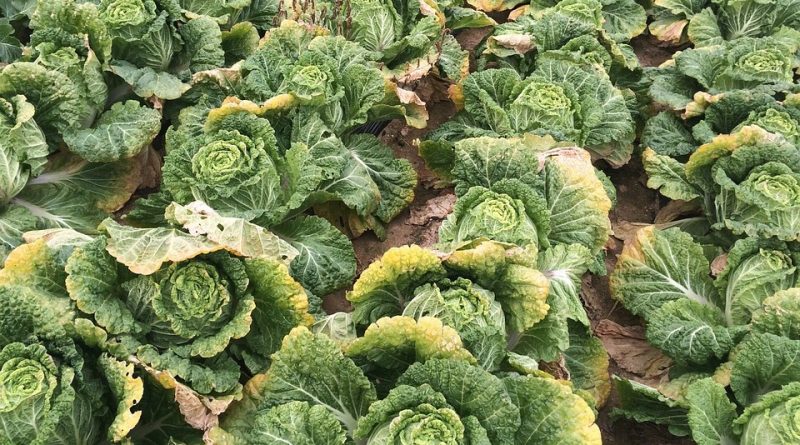Brassica rapa pekinensis
Brassica rapa pekinensis
Napa Cabbage (Brassica rapa subsp. Pekinensis (Lour.) Hanelt) is a herbaceous species belonging to the Brassicaceae family.
Systematic –
From a systematic point of view, it belongs to the Eukaryota Domain, Kingdom Plantae, Subregion Tracheobionta, Superdivision Spermatophyta, Division Magnoliophyta, Class Magnoliopsida, Subclass Dilleniidae, Order Capparales, Family Brassicaceae and therefore to the Genus Brassica, to the Species B. rapa and to the Species B. rapa and the Subspecies B. r . pekinensis.
Etymology –
The term Brassica comes from brassica, the Latin name of the cabbage described by several authors, attested in the literature starting from Plautus (III-II century BC). The origin of this name is uncertain and has been traced back to Greek or Celtic voices, without totally convincing evidence. Several etymological texts refer to the word Βράσκη braske, according to Hesychius used by the Italics in Magna Grecia to indicate cabbage.
The specific epithet rapa comes from rápa or rapum rapa in Columella & al. (from the Greek ρᾰπυς rápys, assonant with ρα ra, contraction of ῥίζα rhiza root, and from πούς pous foot).
The name pekinensis is in reference to the origin of the surroundings of Beijing, the capital of China.
Geographical Distribution and Habitat –
Napa Cabbage is a species that probably originates from China and Eastern Asia, has more than thirty varieties, but few of these are known in the West.
It is mainly grown in this area.
Description –
Brassica rapa subsp. pekinensis is a biennial plant with long, whole leaves that form an elongated head, light in color, turgid but not too hard. Its interior, on the other hand, is almost white and its ribs, very thick, are silver-white.
The flower scape appears the second year and bears yellow flowers grouped in spikes.
The fruits are siliques that enclose small spherical black seeds.
Cultivation –
Napa Cabbage is a typically Chinese vegetable but it is also grown in some countries of Europe, including Poland, while it is not widespread in Italy.
This species is sown within the first days of June, subsequent sowing can be done until August and its collection takes place after about three months.
Uses and Traditions –
Napa Cabbage, known in the West for over three centuries, vaguely recalls the shape of Romaine lettuce, its sweet taste and its elongated shape differentiate it from common cabbage.
The great advantage of the Napa Cabbage, compared to its peers, is that it has a sweet taste and a non-invasive aroma when cooking it.
Like all Brassicaceae, Beijing cabbage is rich in Vitamin C (26 mg / 100g) and Calcium (40 mg / 100g).
100 g of Chinese cabbage provide:
– Energy 16 kcal (68 kJ);
– Carbohydrates 3.2 g;
– Fibers 1.2 g;
– Fat 0.2 g;
– Protein 1.2 g;
– Vitamin C 27 mg (33% of the daily requirement);
– Calcium 77 mg (8%);
– Iron 0.31 mg (2%);
– Magnesium 13 mg (4%);
– Sodium 9 mg (1%).
Napa Cabbage has numerous health beneficial properties.
In particular:
– has very few calories;
– contains many antioxidants, useful for fighting free radicals and cellular aging;
– provides a good quantity of fiber;
– helps keep LDL “bad” cholesterol levels low;
– it is an incredible source of folic acid and vitamin C.
– it also supplies a good quantity of vitamin K and mineral salts, in particular calcium.
Napa Cabbage is widely used in oriental cuisine; in Chinese culture it is a symbol of prosperity.
In Korean cuisine, it is the main ingredient of baechu kimchi, the most common type of kimchi, but it is also used for meat or fish rolls. It is often stir-fried with other ingredients, such as tofu, mushrooms and zucchini.
Method of Preparation –
Napa Cabbage must have compact, firm, fresh stems and must not have spots on the edges of the leaves. If the leaves are opaque and damp, it will mean that the Beijing cabbage is fresh.
It is consumed in various ways, both cooked (for example in broth or stew) and raw, or even after fermentation. It is also used, together with other ingredients, in the filling of various preparations such as the classic jiaozi (steamed ravioli).
This vegetable should be kept in the refrigerator, in the special drawer for vegetables, in this way it will keep for about two weeks. In any case, if possible, it is recommended to eat it as soon as purchased, especially if it will be eaten raw, as it is tastier and more crunchy.
Nothing prevents you from consuming it raw, in a salad, cut into thin strips and simply seasoned with fine salt, white pepper, extra virgin olive oil and lemon juice, perhaps to accompany rather fatty dishes, such as a browned sausage, to which it provides a worthy counterpart. .
When cooking it, there is no need to boil it. Just sauté it in a pan with garlic and, if you like, chili pepper, sauté in oil, over high heat, to make it remain crisp and tasty, perhaps complementing it with seasonal aromatic herbs.
The shape of the leaves, rather elongated, and their fleshy consistency, allow the use of cabbage as a useful container for rolls, both meat and fish.
Guido Bissanti
Sources
– Acta Plantarum – Flora of the Italian Regions.
– Wikipedia, the free encyclopedia.
– Treben M., 2000. Health from the Lord’s Pharmacy, Tips and experiences with medicinal herbs, Ennsthaler Editore
– Pignatti S., 1982. Flora of Italy, Edagricole, Bologna.
– Conti F., Abbate G., Alessandrini A., Blasi C. (edited by), 2005. An annotated checklist of the Italian vascular flora, Palombi Editore.
Warning: Pharmaceutical applications and alimurgical uses are indicated for information purposes only, they do not in any way represent a medical prescription; therefore, no responsibility is accepted for their use for healing, aesthetic or food purposes.


